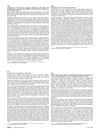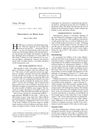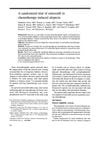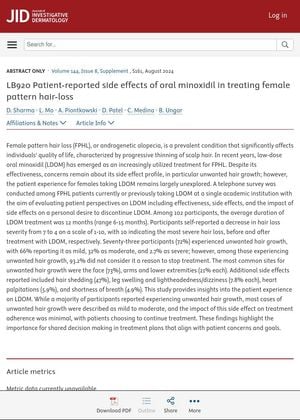TLDR Most women continued using oral minoxidil for hair loss despite mild to moderate side effects.
A telephone survey of 102 female pattern hair loss (FPHL) patients taking low-dose oral minoxidil (LDOM) revealed that while 72% experienced unwanted hair growth, most cases were mild to moderate and did not significantly impact treatment adherence. Participants reported a decrease in hair loss severity from 7 to 4 on a 10-point scale after an average of 12 months of treatment. Other side effects included hair shedding (47%), leg swelling and lightheadedness/dizziness (7.8% each), heart palpitations (5.9%), and shortness of breath (4.9%). Despite these side effects, the majority of patients chose to continue treatment, underscoring the importance of shared decision-making in treatment plans.
 February 2024 in “Cosmoderma”
February 2024 in “Cosmoderma” Low-dose oral minoxidil can help treat male and female pattern hair loss, especially in those who can't use topical treatments or have heart health issues.
February 2020 in “The Pharmaceutical Society of Japan” 8 citations
,
October 2015 in “PubMed” 5% minoxidil foam effectively treats female hair loss.
 May 2015 in “Journal of The American Academy of Dermatology”
May 2015 in “Journal of The American Academy of Dermatology” 5% minoxidil foam helps women with thinning hair.
January 2007 in “Strait Pharmaceutical Journal” Water-soluble minoxidil effectively promoted hair growth in mice.
 1 citations
,
September 2002 in “PubMed”
1 citations
,
September 2002 in “PubMed” Minoxidil helps stimulate hair growth and reduce hair loss in women with androgenic alopecia.
 370 citations
,
September 1999 in “The New England Journal of Medicine”
370 citations
,
September 1999 in “The New England Journal of Medicine” Finasteride and minoxidil are effective for hair loss, but continued research is needed for better treatments.
 127 citations
,
July 1996 in “Journal of The American Academy of Dermatology”
127 citations
,
July 1996 in “Journal of The American Academy of Dermatology” Minoxidil shortens baldness from chemotherapy by 50.2 days without significant side effects.
36 citations
,
January 1991 in “PubMed” 2% Minoxidil does not prevent hair loss during chemotherapy.





